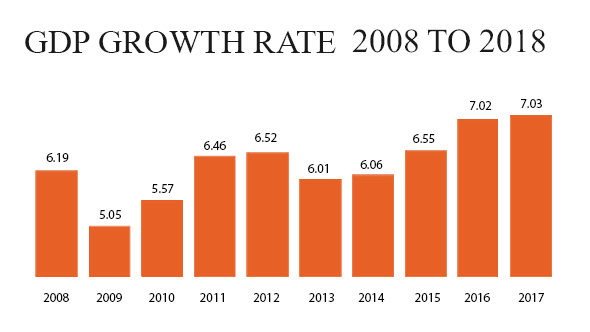Investment In Bangladesh
Economy and GDP of Bangladesh

Bangladesh is one of the most optimistic position among the Asian countries due to investment, foreign exchange savings and increasing productivity in the industrial sector.
GDP growth in fiscal 2017-18 is likely to be 7.65 percent, up from 7.28 percent a year earlier, as per the estimate of the Bangladesh Bureau of Statistics.
This is the third consecutive year that the economic growth was above 7 percent after years of languishing in the neighborhood of 6 percent. The BBS data shows that the agriculture sector, whose contribution to the GDP is 14.10 percent, grew 3.06 percent in fiscal 2017-18, up from 2.97 percent last year.
The services sector, whose contribution to the GDP is 52.85 percent, grew 6.33 percent this year, down from 6.69 percent registered a year earlier.
The industrial sector, whose contribution to the GDP is 33.71 percent, grew 11.99 percent against 10.22 percent in fiscal 2016-17.
In dollar term, the GDP size is $274.5 billion this fiscal year, which was $249 billion last year. The country's per capita income is $1,752, which was $1,610 in fiscal 2016-17.
The work of various mega projects including the Padma bridge and metro-rail are advancing rapidly, said the BBS report.
Economy and GDP of Bangladesh
Investment in both the public and private sectors is rising this year. In the construction and housing sector, there is a positive trend this time. This is why the industrial output is increasing.
The Asian Development Bank has projected 7 percent economic growth for Bangladesh for the current fiscal year, much below than the government’s provisional estimate of 7.65 percent.
Growth has exceeded expectations despite slower export expansion and declining remittances, said the bank while unveiling its Asian Development Outlook 2018.
It said GDP growth is expected to moderate to 7 percent in FY2017-18 as consumption demand slackens despite a rebound in worker remittances.
The ADB projection is much lower than what the state-run Bangladesh Bureau of Statistics is estimating.
Bangladesh Bureau of Statistics said GDP growth in fiscal 2017-18 is likely to be 7.65 percent, up from 7.28 percent a year earlier.
Economic zones across the country are ready to give the best opportunities that investors want most.
The World Bank has painted a brighter picture for Bangladesh's economy for the next two fiscal years, pinning hopes on strong domestic demand, exports, investment and remittance.
The Global Economic Prospects, a flagship report of the World Bank Group, said activity in Bangladesh would grow at an average of 6.7 percent a year over fiscals 2018-2020, benefiting from strong domestic demand and strengthening exports.
Bangladesh is among the top 17 out of 134 countries in the list of GEP forecasts that are projected to have a growth rate of 6.4 percent or more in 2017-18, said Zahid Hussain, lead economist of the World Bank's Dhaka office.
The Bangladesh economy is projected to grow 6.4 percent in 2017-18. The government's Seventh Five-Year Plan aims to achieve 7.4 percent GDP growth annually for 2015-16 and 2019-20.
The year 2018 is a turning point for Bangladesh in many ways. Bangladesh prepare to graduate from the least developed country status in 2018. It will also continue its efforts toward becoming a middle-income country. Additionally, it will continue to implement the sustainable development goals (SDGs). These will hinge on a number of factors such as accelerated resource mobilization, higher investment, efficiency in infrastructure implementation, skilled human resources and strong institutional set up.
Lastly, Bangladesh has placed significant emphasis on the growth rate of its gross domestic product while the quality and distributional aspects of GDP growth have been overlooked. Incremental benefit from such growth has accrued to the rich rather than the poor. It is disturbing to note that top 10 percent possess 38 percent of Bangladesh's total income while the bottom 10 percent only has one percent of the total income of the country.
High growth is yet to be translated into generation of enough income for the poor, creation of employment, access to quality education and better healthcare for all, and above all, reducing income inequality. In the coming years, policymakers must make broader development goals their objectives instead of being overwhelmed by narrow growth targets.